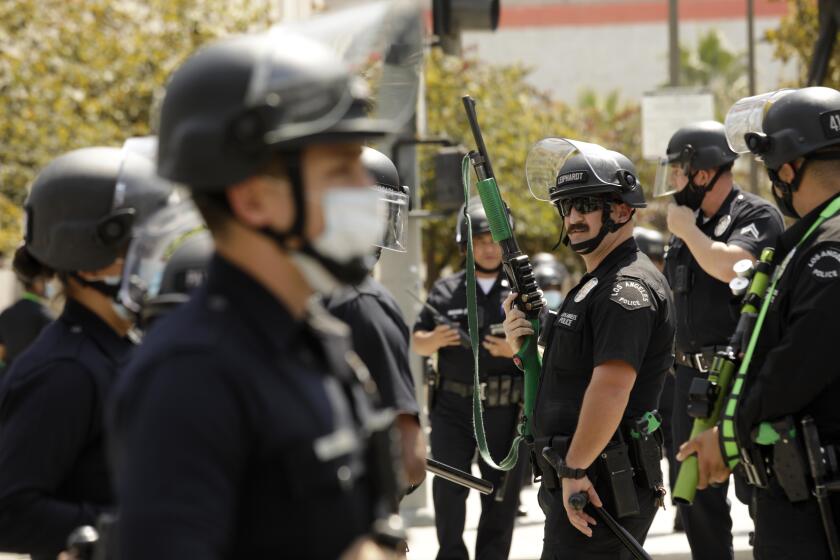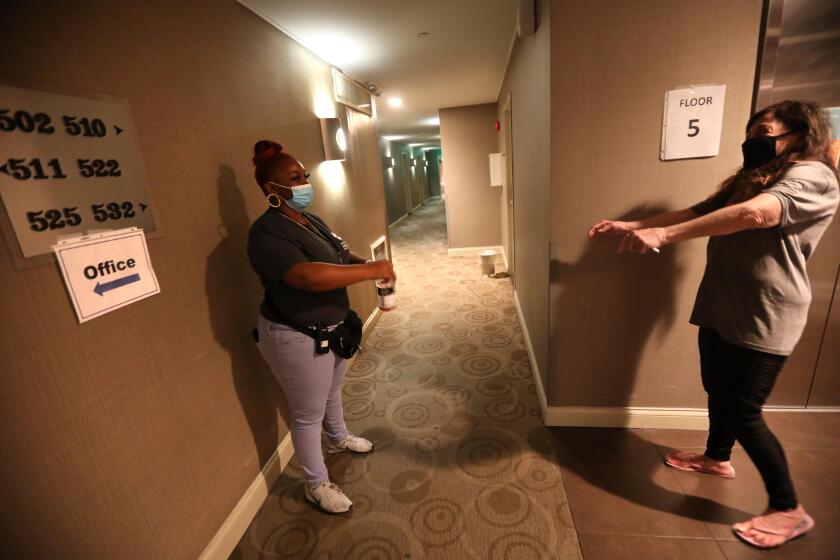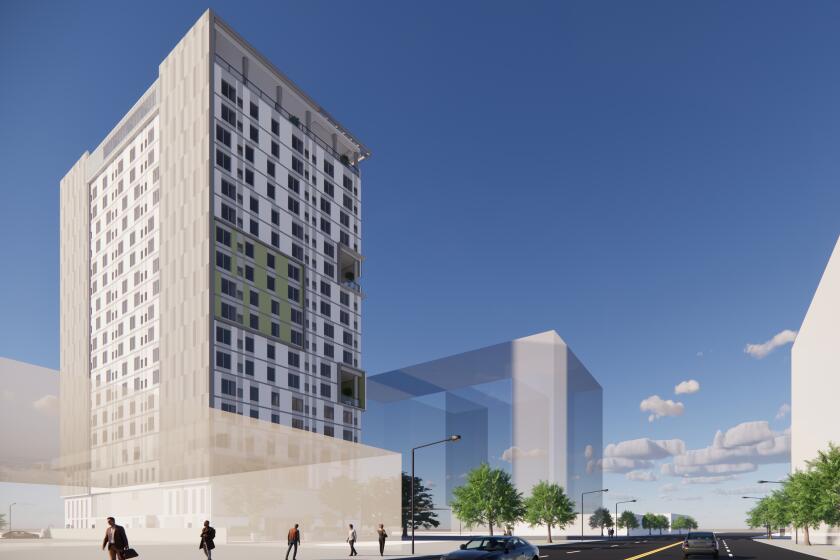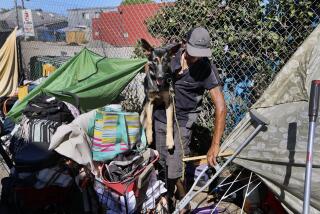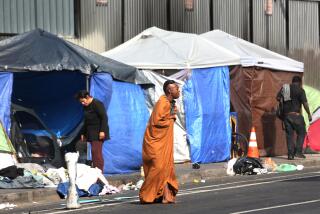Minority of sanitation workers report being vaccinated, worrying homeless advocates
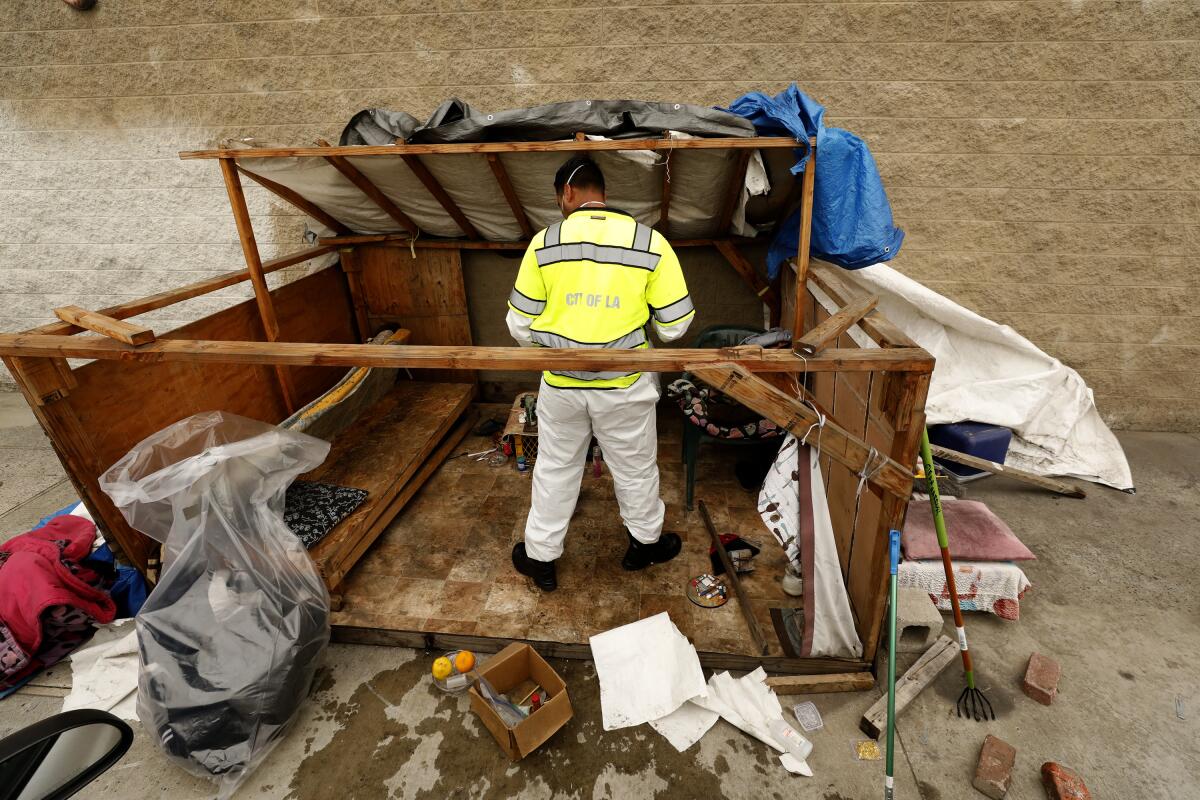
Update: About 78% of Los Angeles sanitation workers assigned to clean homeless encampments have reported being fully or partially vaccinated, officials said Thursday, Sept. 30.
In March 2020, Los Angeles sanitation crews mostly stopped doing their most extensive cleanups at homeless encampments, hoping to reduce the chances of spreading COVID-19 on the streets.
More than a year later, the number of residents becoming sick from the virus has dropped and the cleanups have resumed. But advocates for homeless people warn that the risks from COVID-19 are still present, and they fear the renewed cleanups will spread the virus among the unhoused.
Adding to the fear is the fact that many sanitation workers — possibly even most — are still not vaccinated.
“Resuming these activities now will undoubtedly bring unvaccinated city workers in contact with people experiencing homelessness, which could have devastating consequences for unhoused individuals, city employees, and the entire Los Angeles community,” wrote Services Not Sweeps, a coalition of homeless activists, in a letter to City Councilman Mark Ridley-Thomas last month.
The city never stopped doing its smaller, less invasive Cleaning and Rapid Engagement cleanups, known as CARE, which typically allow tents to remain on the sidewalk.
The newly restarted, more comprehensive CARE+ operations require that everything be moved — tents, mattresses, bicycle parts, and so on — so sidewalks can be power-washed with a combination of water and bleach.
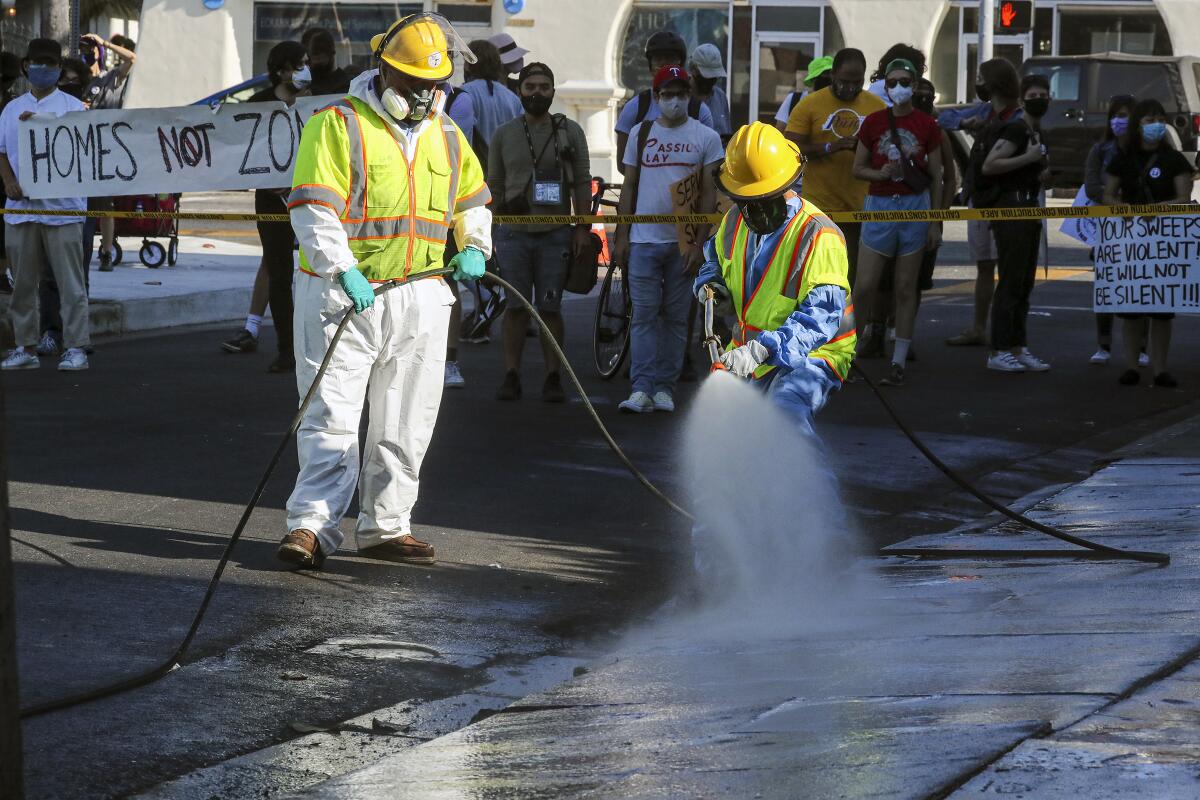
Lawyers and activists for homeless people characterize the more comprehensive CARE+ cleanup operations as sweeps because they sometimes cause people to lose their possessions or relocate permanently.
The CARE+ cleanups had stopped last spring as city leaders attempted to adhere to guidance from the Centers for Disease Control and Prevention against dispersing encampments for fear of spreading COVID-19.
Advocates who work in encampments say vaccination rates among L.A.’s homeless population are still relatively low compared to the broader population. Vaccination requirements still haven’t gone into effect for city workers doing the cleanups.
Two weeks ago, the Los Angeles County Department of Public Health reported that an estimated 43.5% of the homeless population is vaccinated.
Sanitation workers may have an even lower vaccination rate. Elena Stern, a spokeswoman for the Department of Public Works, said only 38% of employees have reported being fully or partially vaccinated, while 58% haven’t yet disclosed their vaccination status. Workers have until Oct. 19 to report their vaccine status, Stern said.
Vaccination requirements will become a condition of city employment the following day.
More than 2,600 LAPD employees have indicated that they plan to pursue religious exemptions, while more than 350 plan to seek medical ones, according to a source in city government.
When sanitation workers become aware of an outbreak or positive case in an encampment, they carry out less invasive “spot cleanings” to allow individuals to shelter in place and to avoid contact with cleanup teams, Stern said. Cleanup crews also are required to wear N95 masks, protective suits and gloves.
Sanitation officials argue that the more comprehensive cleanups are also driven by public health concerns, to ensure that encampments do not suffer from an outbreak of hepatitis, typhus or other illnesses. During CARE+ cleanups, sanitation crews throw away objects that have food waste, human waste or other hazardous materials on them, officials said.
“Let’s say, for example, a location is conducive to a rodent infestation,” Salvador Rosales, chief environmental inspector with the Bureau of Sanitation, said. “That can cause a situation where typhus can impact humans.”
Project Roomkey, a state program backed by federal dollars, was intended to house homeless people during the pandemic. But it never got close to its goal.
After a months-long lull in which new coronavirus infections in homeless people averaged fewer than four a day, a new surge began in mid-August that has since averaged 18 new cases a day. The figure peaked at 26 new cases a day before trending downward.
Research has shown that in Los Angeles County, homeless COVID-19 patients are 50% more likely to die than those in the general population.
Because most sanitation workers work outside, the risks of transmission are lower, according to Barbara Ferrer, the L.A. County public health director. Still, she said, the best thing people can do is get vaccinated.
“You protect yourself and protect everyone else around you,” she said. “In all workplaces and spaces, that’s the most sensible way forward.”
The letter to Ridley-Thomas notes that the sanitation department’s general manager previously disclosed that 70 members of the cleanup teams contracted COVID-19 during the last winter surge.
Ridley-Thomas, who serves as the Homelessness and Poverty Committee chair, said his most pressing concern is getting city workers vaccinated faster. In addition to sanitation workers, city officials have said that only 56% of Los Angeles Police Department employees, who also attend the cleanups, have been fully vaccinated.
Ridley-Thomas said recently approved strategies about how to handle encampment outreach will help get more people off the street in the most humane way possible. The plan calls for the hiring of three teams of outreach workers in each council district, which would be dispatched to help get people off the street, he said.
The outreach teams will help build trust with homeless people, persuading them to leave encampments and accept shelter, he said.
“The tools at the disposal of law enforcement are entirely too limited to be helpful in this instance,” he said.
The push for more outreach workers was approved shortly after the L.A. City Council passed an ordinance that would allow city leaders to prohibit camping around parks, libraries, schools, bridges and other areas. Critics contend the law punishes people for living on the streets.
The council has not yet selected any locations for enforcement.
Construction kicked off Tuesday on a 19-story homeless housing project designed to reshape a corner of L.A.’s skid row.
Mayor Eric Garcetti told The Times earlier this month that it was good to start cleanups again so long as outreach workers were also helping people get off the streets and into housing.
“It’s a full package of trying to make sure that nothing gets too embedded on the street, because people die on that street. People get sick on the street,” Garcetti said.
Kim Olsen, a homeless activist in the San Fernando Valley, regularly goes to cleanups and says they often aren’t as humane as billed. Encampment cleanups have disrupted people who were trying to quarantine after either having tested positive or being exposed to COVID-19, she said.
Olsen also said that the information being relayed to unhoused people is often contradictory or hard to understand. In addition, people in the encampments she regularly visits say that when cleanups occur, they tend to have possessions trashed or removed.
She said the displacements might further the spread of COVID-19 because some people relocate when the cleanups occur and don’t come back.
Leonidas Contreras, 34, lives in a West Valley encampment and tested positive this month for COVID-19. He also has asthma, and the double blow left him bedridden and exhausted. Preparing for the cleanup was hard enough. When the cleanup occurred, he told sanitation workers he was sick and stayed in the tent he shares with his girlfriend.
When it was over, sanitation workers had taken some but not all of the trash he had piled up. They also threw out a power washer he had kept for the engine detailing business he’s been trying to start up again, Contreras said.
In past cleanups he’s lost his GED paperwork and the only picture of his daughter.
“Imagine just trying to go apply for a job and you get the job, but then not knowing if you will have clothes to get to work to in tomorrow,” he said.
Sanitation crews post notices about the CARE+ cleanups at least 24 hours in advance. Once they begin, tents and other possessions that do not have hazardous materials on them — but are still on the sidewalk — are labeled and taken to storage facilities, where they are kept 90 days before being thrown out, public works officials said.
Once the cleanups are finished, homeless people may return to the spot on the sidewalk where they had been staying, officials said.
Times staff writers Doug Smith and Emily Alpert Reyes contributed to this report.
More to Read
Sign up for Essential California
The most important California stories and recommendations in your inbox every morning.
You may occasionally receive promotional content from the Los Angeles Times.
